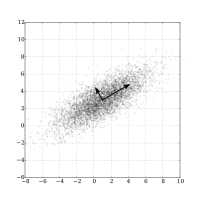
Photo from wikipedia
The magneto-elastic 1:3 principal-internal resonance of axially moving current-carrying beams in a magnetic field is investigated. With the elastic theory of Euler–Bernoulli beam and the basic theory of electromagnetic field… Click to show full abstract
The magneto-elastic 1:3 principal-internal resonance of axially moving current-carrying beams in a magnetic field is investigated. With the elastic theory of Euler–Bernoulli beam and the basic theory of electromagnetic field taken into account, the magneto-elastic vibration equation of an axially moving beam in a magnetic field is therefore developed by the Hamiltonian principle. On the basis of the hypothetical two-order modal shape function satisfying the fixed-hinged boundary condition, amplitude–frequency response equations of the 1:3 principal-internal resonance are obtained by Galerkin and multi-scale method. Calculation results based on relevant MATLAB programming, show that: When the system first-order primary resonance occurs, the second-order modal amplitude that should be disappeared excited by internal resonance, but its value is smaller than the first-order modal amplitude. It has only two changing stages and lacks a small single-value area in the curve of amplitude and external excitation force amplitude for the first-order primary resonance of the system; the curves of amplitude versus magnetic field strength, influenced by applied current, exhibit an asymmetric distribution property along the longitudinal line where the value of the magnetic field strength is zero; the response can be dominated by the first mode in the second-order primary-internal resonance of the system, in which the amplitude of the external excitation must exceed a critical value before the first mode can be excited. In addition, such as the axial velocity, the magnetic field strength, the excitation amplitude and the tuning parameters have a significant effect on the amplitude of the system, especially the magnetic field has an obvious inhibitory effect on the vibration.
Journal Title: Nonlinear Dynamics
Year Published: 2017
Link to full text (if available)
Share on Social Media: Sign Up to like & get
recommendations!